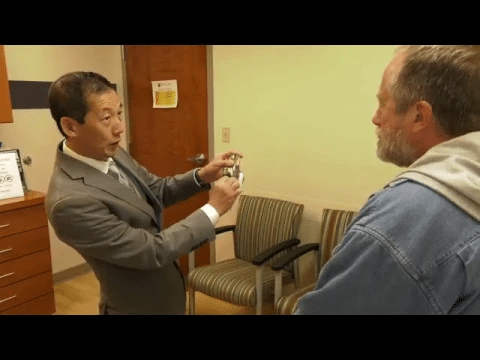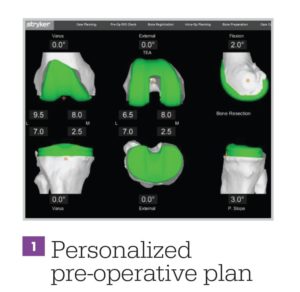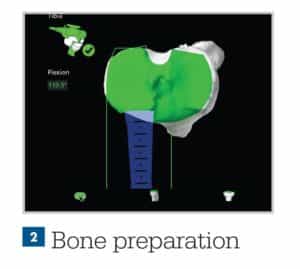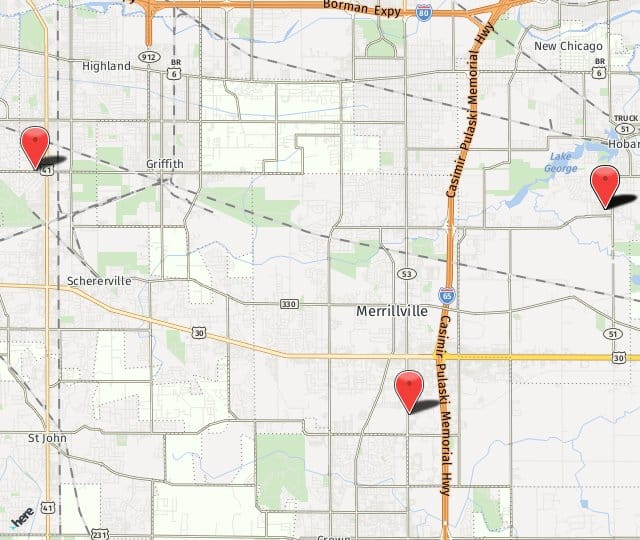Convenient Locations in Highland, Hobart, & Merrillville
This is Mako, a robotic-arm assisted technology that helps surgeons provide patients with a personalized surgical experience. A 3D model of your hip or knee will be used to pre-plan and assist your surgeon in performing your joint replacement surgery. Dr. Ham performs this procedure at Northwest Regional Surgery Center.

Robotic-arm Assisted Technology for Total Knee Replacement
We understand that making sure you know what to expect from your joint replacement experience is important to you. As you are reading through this material, if you have additional questions please reach out to us to discuss.
Patient Testimonial
"I’m a 63 year old walking and golfing advertisement for this group of doctors. Dr Schwartz has repaired my wrist, my shoulder, and helped with tendinitis in my arms. Dr Ham operated on a meniscus tear in my knee. The office is pretty good and they run close to on time. The therapy section is also excellent."
Who is a Candidate for Robotic Total Knee Replacement?
Each patient is unique, and can experience joint pain for different reasons. It’s important to talk to us about the reason for your knee pain so you can understand the treatment options available to you. Pain from arthritis and joint degeneration can be constant or come and go, occur with movement or after a period of rest, or be located in one spot or many parts of the body. It is common for patients to try medication and other conservative treatments to treat their knee pain. If you haven’t experienced adequate relief with those treatment options, you may be a candidate for Mako Total Knee replacement, which may provide you with relief from your knee pain.
How Robotic Arm Assisted Knee Replacement Works

Mako Robotic-Arm Assisted Total Knee replacement is a treatment option for adults living with mid to late-stage osteoarthritis (OA) of the knee. Mako provides you with a personalized surgical plan based on your unique anatomy. First, a CT scan of the diseased knee joint is taken. This CT scan is uploaded into the Mako System software, where a 3D model of your knee is created. This 3D model is used to pre-plan and assist your surgeon in performing your total knee replacement.

In the operating room, your surgeon follows your personalized surgical plan while preparing the bone for the Triathlon Total Knee implant. With over a decade of clinical history, Triathlon knee replacements are different than traditional knee replacements because they are designed to work with the body to promote natural-like circular motion.
The surgeon guides the robotic-arm to remove diseased bone and cartilage within the pre-defined area and the Mako System helps the surgeon stay within the planned boundaries that were defined when the personalized pre-operative plan was created.¹⁻⁴
In a laboratory study, Mako Technology demonstrated accurate placement of implants to a personalized surgical plan.
Is the Robotic Arm Manually Controlled During Total Knee Replacement?
It’s important to understand that the surgery is performed by an orthopaedic surgeon, who guides the robotic-arm during the surgery to position the implant in the knee joint. The robotic-arm does not perform surgery, make decisions on its own, or move without the surgeon guiding the robotic-arm. The Mako System also allows your surgeon to make adjustments to your plan during surgery as needed.
Important Information
Knee Replacements
General indications: Total knee replacement is intended for use in individuals with joint disease resulting from degenerative, rheumatoid and post-traumatic arthritis, and for moderate deformity of the knee.
Contraindications: Knee replacement surgery is not appropriate for patients with certain types of infections, any mental or neuromuscular disorder which would create an unacceptable risk of prosthesis instability, prosthesis fixation failure or complications in postoperative care, compromised bone stock, skeletal immaturity, or severe instability of the knee.
What Are the Risks of Knee Replacement?
As with any surgery, knee replacement surgery has serious risks which include, but are not limited to, peripheral neuropathies (nerve damage), circulatory compromise (including deep vein thrombosis (blood clots in the legs)), genitourinary disorders (including kidney failure), gastrointestinal disorders (including paralytic ileus (loss of intestinal digestive movement)), vascular disorders (including thrombus (blood clots), blood loss, or changes in blood pressure or heart rhythm), bronchopulmonary disorders (including emboli, stroke or pneumonia), heart attack, and death.
Implant related risks which may lead to a revision include dislocation, loosening, fracture, nerve damage, heterotopic bone formation (abnormal bone growth in tissue), wear of the implant, metal sensitivity, soft tissue imbalance, osteolysis (localized progressive bone loss), and reaction to particle debris. Knee implants may not provide the same feel or performance characteristics experienced with a normal healthy joint.
The information presented is for educational purposes only. Speak to your doctor to decide if joint replacement surgery is right for you. Individual results vary and not all patients will receive the same postoperative activity level. The lifetime of a joint replacement is not infinite and varies with each individual. Your doctor will help counsel you about how to best maintain your activities in order to potentially prolong the lifetime of the device. Such strategies include not engaging in high-impact activities, such as running, as well as maintaining a healthy weight. Ask your doctor if the Triathlon knee is right for you.
Stryker Corporation or its other divisions or other corporate affiliated entities own, use or have applied for the following trademarks or service marks: Mako, Stryker, Triathlon. All other trademarks are trademarks of their respected owners or holders.
Robotic Hip Replacement
Similar to our knee replacement procedure, we are proud to also use advanced robotics technology to help patients who need full hip replacements.
What is Robotic Hip Replacement?
A robotic hip replacement is the process of removing damaged tissue in the hip and replacing it with an artificial joint. Using this artificial joint allows for greater flexibility and precision compared to the results from traditional hip replacement surgeries. Because robotic techniques have been proven to be twice as accurate as manual surgery, this angle of the artificial joint in the hip replacement can be more correctly placed. Through this, your surgeon will be able to more accurately place the joint in a more natural-feeling position. This often leads to a smoother recovery, better flexibility, and easier mobility in patients who struggled with hip pain prior to their hip replacement procedure.
Who Is a Good Candidate for Robotic Hip Replacement?
The ideal candidates for robotic hip replacements are those who are in overall good health and experience complications or pain from the joints in their hip. If your body hasn’t responded to more natural ways of healing, such as physical therapy, and you still experience pain in your hip from sitting, standing, or walking, a robotic hip replacement may benefit you.
If you have an active infection or sepsis, this procedure is not recommended for you. The recovery process from a robotic hip replacement surgery may also be very difficult for patients who are overweight or obese. We recommend patients are able to maintain a stable weight before beginning their procedure.
How Can I Prepare for my Robotic Hip Replacement?
Patients who take the most time preparing for their hip replacement procedure often go through an easier recovery process. The more you are prepared for your procedure, the fewer complications you’ll experience while you heal. We recommend taking the following preparatory actions before the day of your hip replacement surgery:
- Consult with your doctor to stop all medications, especially ones that are anti-inflammatory or blood thinners.
- Quit smoking. Smoking causes the blood vessels to narrow, which can prevent nutrients, blood, and oxygen from helping your wounds to heal.
- Implement a healthy diet and exercise routine to lose a few pounds and maintain a stable weight before your surgery.
- Do muscle-strengthening exercises to strengthen your muscles so that not all of your body’s pressure falls on your newly replaced joints.
How Long Will It Take to Recover from a Robotic Hip Replacement?
Hip replacement recovery can be a long journey. However, not impossible. Because it involves the retraining of the muscles and joints on a frequently used part of the body, this recovery process can be difficult at times, but with the right support system and careful following of your surgeon’s guidance, patients are able to return to their normal routines within 10 to 12 weeks. Although patients may still experience slight discomfort in the months to follow, after a full year, most patients are pain-free and can enjoy their new hips for at least the next 20 years.
Schedule a Client Consultation in Northwest Indiana today!
If you are interested in learning more about New Technologies we offer or to schedule a consultation, please call one of our offices at 219.795.3360 to get started today! Our offices are located in Merrillville, Highland, Hobart, & Valparaiso, IN.
References
- Mistry J, Elmallah R, Chughtai M, Oktem M, Harwin S, Mont M. Long-Term Survivorship and Clinical Outcomes of a Single Radius Total Knee Arthroplasty. International XXVIII.
- Designed to maintain collateral ligament stability throughout the range of motion. Stryker-Initiated Dynamic Computer Simulations of Passive ROM and Oxford Rig Test, Stephen Piazza, 2003.
- Wang H, Simpson KJ, Ferrara MS, Chamnongkich S, Kinsey T, Mahoney, OM. Biomechanical differences exhibited during sit-to-stand between total knee arthroplasty designs of varying radii. J Arthroplasty. 2006;21(8):1193-1199.
- Gómez-Barrena E, Fernandez-García C, Fernandez- Bravo A, Cutillas-Ruiz R, Bermejo-Fernandez G. Functional performance with a single-radius femoral design total knee arthroplasty. Clin Ortho Relates Res. 2010;468(5):1214-1220.
- Hampp E. et al. Robotic-Arm Assisted Total Knee Arthroplasty Demonstrated Greater Accuracy to Plan Compared to Manual Technique. Orthopaedic Research Society 2017 Annual Meeting, San Diego, CA. Poster No. 2412. March 20-22, 2017.
MKOHMT-PE-3_Rev-1_13841
Copyright © 2017 Stryker Corporation

